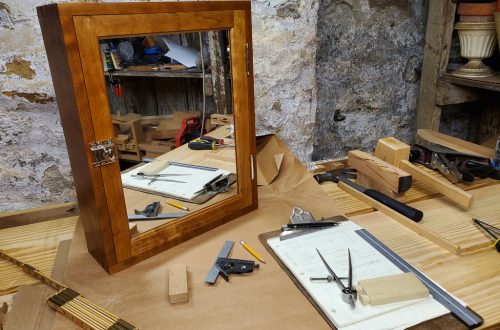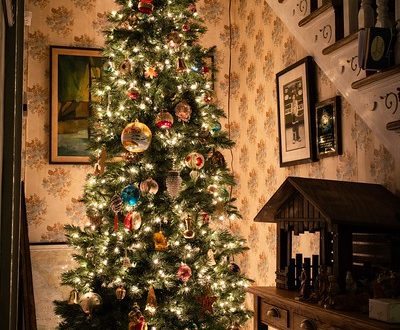The Good Old Days
 For the first part of my life, my family lived in an old house in a very small town in Central Pennsylvania. My parents heated the house using a wood burning stove. My dad had a permit from the forestry department to cut firewood. Every summer or fall he would go to the top of Mount Dempsey with his pickup and his chainsaw. He had to cut enough to last us all winter.
For the first part of my life, my family lived in an old house in a very small town in Central Pennsylvania. My parents heated the house using a wood burning stove. My dad had a permit from the forestry department to cut firewood. Every summer or fall he would go to the top of Mount Dempsey with his pickup and his chainsaw. He had to cut enough to last us all winter.
Sometimes he brought the family with him. I would get out of the truck and walk up and down the narrow forestry road, watching out for snakes. At least once my dad found a rattlesnake up there.
My mom canned vegetables and sewed a lot of the clothes for us kids, as well as dresses for our dolls. One October morning when I was four years old, she went to the grocery store and discovered that the town’s Halloween parade and trick-or-treating was that very night. She hurried home and finished making the pink rabbit costume that she had started.
My parents weren’t trying to be hippies. They just did whatever they could to stretch their money and have a good life. My dad was a new-ish high school teacher at a poor and rural school district.
Medical helicopters weren’t “a thing” in Perry County back then. Also, the nearest trauma center was 50 miles from our town (Blain, PA). I know this because Dad was one of the volunteer ambulance drivers for the volunteer fire department. When a local Amish boy fell out of a barn loft and split his head open, Dad took him on that 50 mile road trip to Hershey Medical Center. I fell asleep waiting for Dad to come home. For weeks afterward I worried about falling out of my tree house.
You just read my personal version of the Good Old Days.
Today I read about Sarah A. Chrisman’s version of the Good Old Days on the website Vox. The article’s title pretty much summarizes its content: “I love the Victorian era. So I decided to live in it.”
Basically, the author claims that she and her husband are living re-enactors of a middle-class or upper-class Victorian lifestyle. She or they make all of their own (Victorian) clothes, they only engage in middle-class or upper-class Victorian recreation, they rejected most “modern” technology and conveniences, etc. And then they blog about how this makes them better people. The author claims that she puts more effort into being a Victorian than she puts into her job. However, it looks as if being Victorian actually “is” her job because her new book is available for pre-order at Barnes & Noble and the blog advises that she is available for presentations.
I can’t figure out whether they use indoor plumbing. Also, this author apparently has access to a computer and an internet connection.
The message board where I found this article has a lot of vitriol for it. So do many, many spin-off articles and blog posts that were posted ever since this article appeared on the internet YESTERDAY. My, there are A LOT of ways to say:” The Victorian era was not a fantastic time for most of the people who lived through it.”
I agree. I don’t envy the Victorians, and I don’t envy the author of this article. However, the photos in this article were kind of cool.
Soon I will write a blog post about how the ORIGINAL owner of my own 1890’s Victorian house – the guy who had the house built to his specifications – modernized his home every time he got access to new technology.
For now, though, I just want to let you know about a place – very close to New Kensington – that you can tour if you like or love the Victorian era and / or Victorian houses. This is a (Queen Anne) Victorian house that was turned into a museum in Oakmont, PA. Here is the blog entry that I wrote last spring but didn’t post until today:
My sister Liz and I toured the Kerr Memorial Museum in Oakmont, PA.
Dr. Thomas Kerr, a physician, had the house built in 1897, and his daughter Virginia lived there until her death in 1994. The house is now a museum depicting the Victorian lifestyle of a professional family from the 1890’s to 1910.
The tour took about an hour. We had an excellent guide who knew much about both the Kerr family and Victorian daily life. We saw the basement with its old-time laundry facilities, all of the family’s living areas, and Dr. Kerr’s office.
I just re-binge-read LM Montgomery’s “Anne of Green Gables” books. Partway through the “Anne” series, the main character marries Gilbert Blythe shortly after he graduates from medical school in the 1890’s. (Jonathan Crombie, who played Gilbert in the most recently made “Anne” movies, tragically passed away this weekend.) As I toured the Kerr house and saw all of the antiques that filled it, I thought about how Anne and Gilbert Blythe’s fictional house, and fictional possessions, would have looked much the same. I saw Dr. Kerr’s medical school diploma from the University of Pittsburgh framed on the wall of his office, and I thought that Gilbert Blythe’s fictional office and medical school diploma from his fictional medical school must be similar.
The museum’s current exhibit “Victorian Mourning Customs,” included black-bordered “mourning cards” that bereaved family members would have used to notify family and friends by mail of a loved one’s passing. Our culture went from sharing news via view hand-written notes through snail mail to instantaneously on “the cloud.” (That’s what they call it now, right? The cloud?)
The Kerr family, especially Virginia, saw so many changes in scientific knowledge and technology from the 1890’s until Virginia’s death in 1994. Just think of all of the medical advances that Dr. Kerr came across in his career!
__
The above link to the museum pretty much tells you what you need to know for your visit. I just want to add that I found plenty of on-street parking. This was a fun way to walk through the Victorian era without having to stay in it. Go ahead – take a few hours and visit the Good Old Days.


